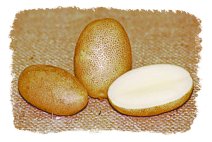
- Shape: Oblong
- Skin: Dark Russet
- Flesh: White
- Market Use: Fresh Markets
- Medium to Late Maturing
 |
Characteristics
|
Plant/roots Vine is medium to large, upright, with lavender flowers; determinate growth habit;
moderate root system.
Tubers are white fleshed, oblong to slightly flat with shallow eyes and a dark, heavy russeted skin;
medium to high specific gravity (1.085).
Yield potential 350 to 450 cwt. range.
Irrigation Irrigation interval at the maximum ET is three days. Drought tolerance is moderate to
poor due to a limited root system. "Illvater stress will affect tuber quality. Excess water can
cause enlarged lenticels that remain visible throughout storage and act as entry points for disease
organisms.
Insects Psyllid injury is common and easily seen in this cultivar. Control measures generally are effective against this problems as wel@ as other insects.
Fungicides One to three applications may be necessary for the control of foliar early blight.
Tuberization/bulking Tubers are set in the middle of the hill with bulking occurring rapidly after
mid-season. They may be susceptible to growth cracks and hollow heart if poor irrigation
management is used. Centennial is generally resistant to second growth problems.
Vine Kill Average days from planting to vine kill is 1 1 5 to 1 20. Vine killing is required in most
years. Vines are easily killed and adequate skin set occurs within eight to 1 4 days. Tubers can
become large late in the season, careful monitoring is necessary after mid-August.
Field
Foliar early blight Moderately Resistant
Verticillium wilt Moderately Resistant
Blackleg Susceptible
Seedpiece decay Moderately Susceptible
Leafroll virus Moderately Resistant
Leafroll Net necrosis Resistant
PVY Susceptible
PVX Susceptible
Common Scab Susceptible
Bacterial ring rot Susceptible
Bacterial soft rot Susceptible
Fusarium dry rot Moderately Resistant
Leak (Pythium) Susceptible
Pink rot (Phytophthora) Susceptible
Silver scurf Susceptible
Rhizoctonia scurf Moderately Resistant
Disease reaction ratings susceotible, moderately susceotible, moderate, moderately resistant and resistant.
Note: This information should only be used as a guide. Adjustments for local conditions must always be made.